Abstract
A kinetic study of the inward transport of uridine in erythrocytes of rabbit, human, mouse, rat and guinea-pig demonstrated that the apparent Km of this process was similar (about 0.2mM) in these cell types, but Vmax. values differed markedly. In this array of cell types, Vmax. values were proportional to the number of transport-inhibitory, high-affinity binding sites present per cell of each type. Transport of uridine or adenosine was not detected in dog erythrocytes, nor was saturable, high-affinity binding of nitrobenzylthioinosine demonstrable. These findings demonstrate that species differences in nucleoside transport capacity are attributable to differences in the cell-surface content of functional nucleoside transport sites, rather than to differences in the kinetic properties of these sites.
Full text
PDF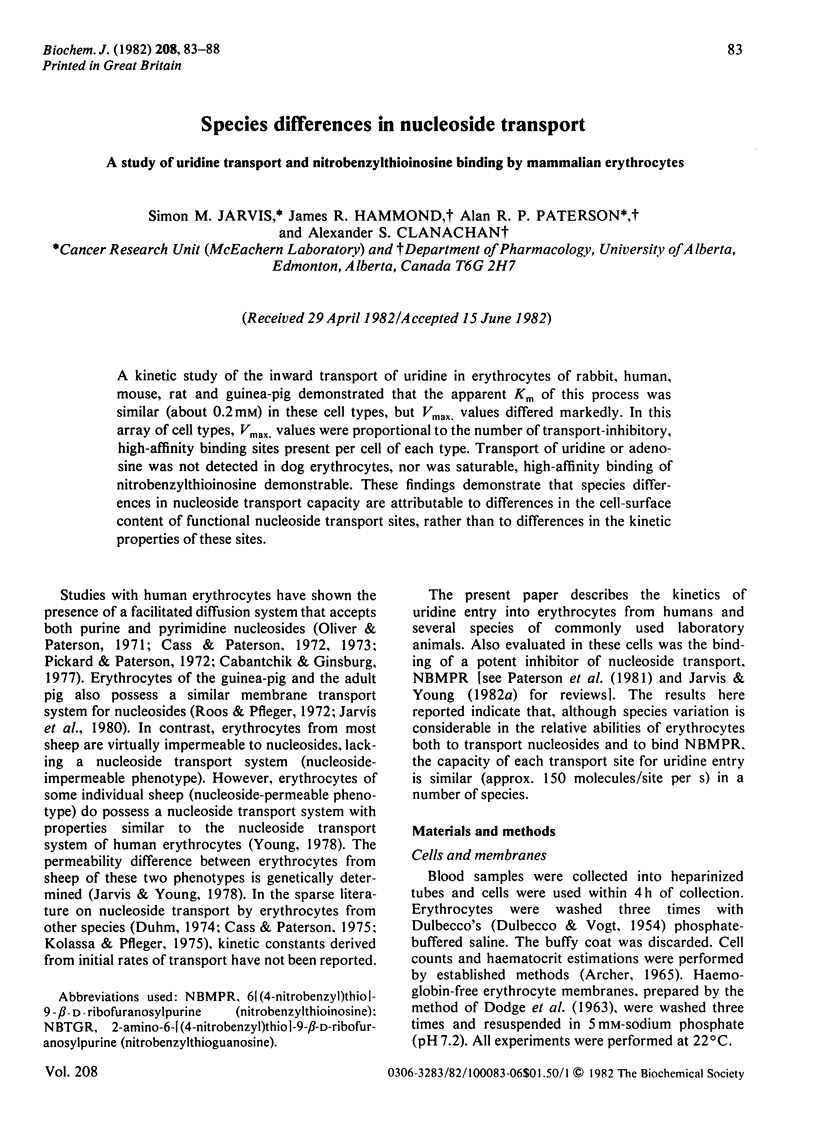
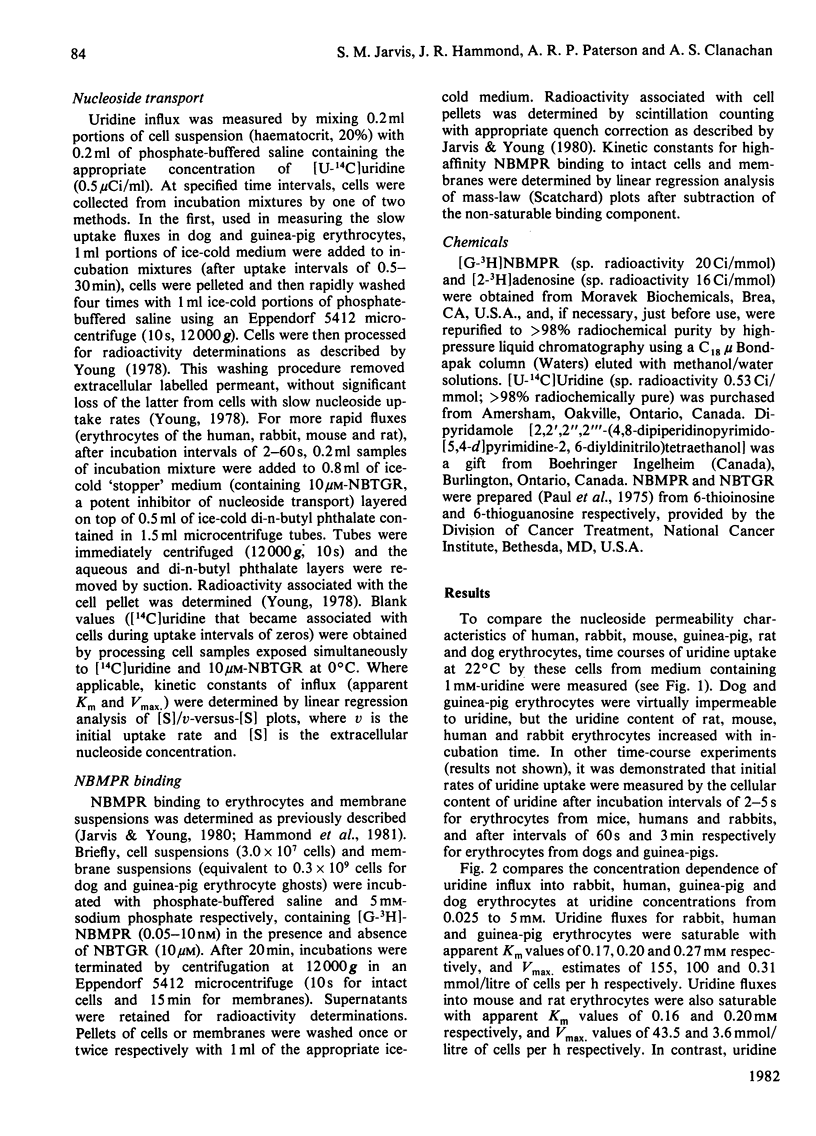
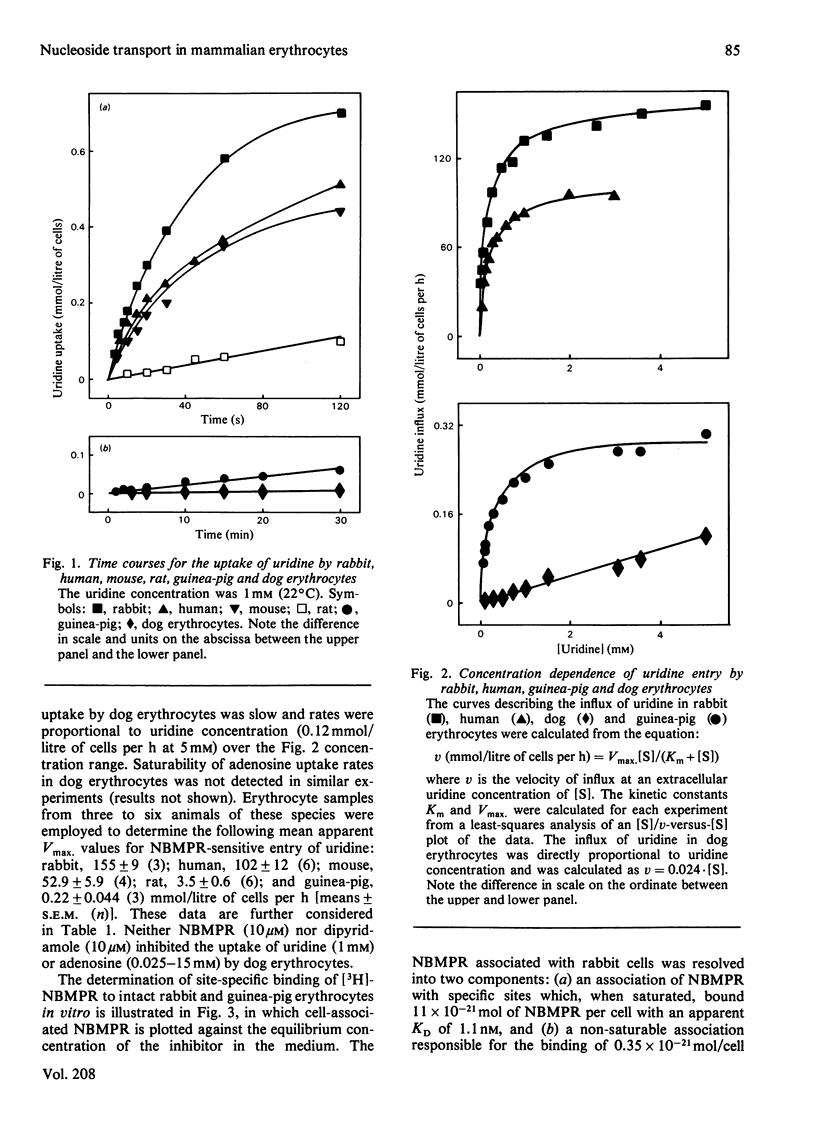
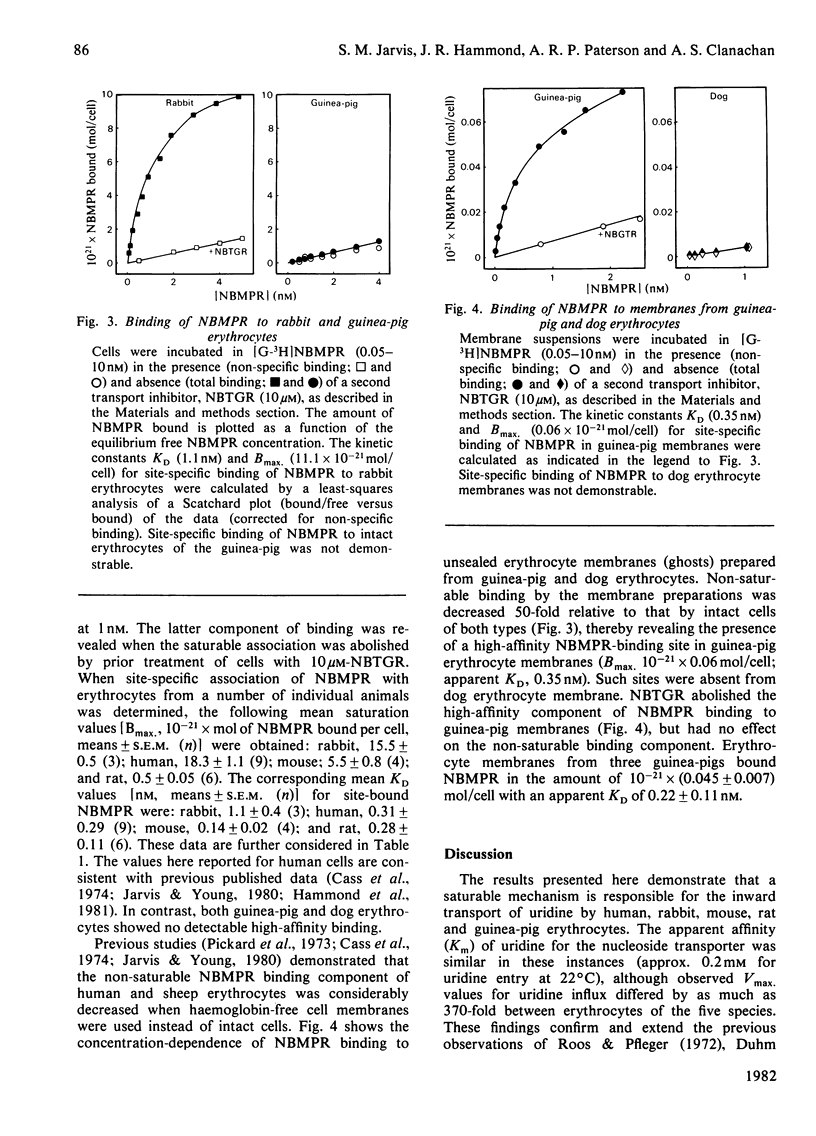
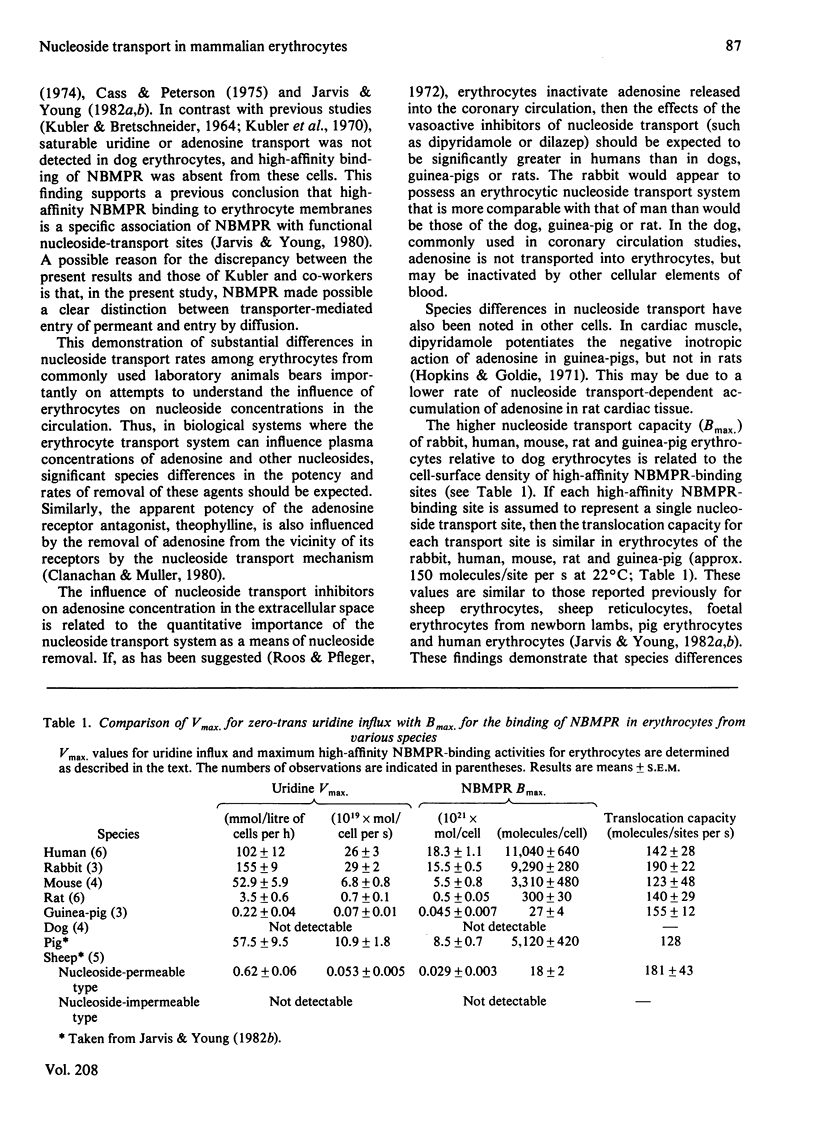
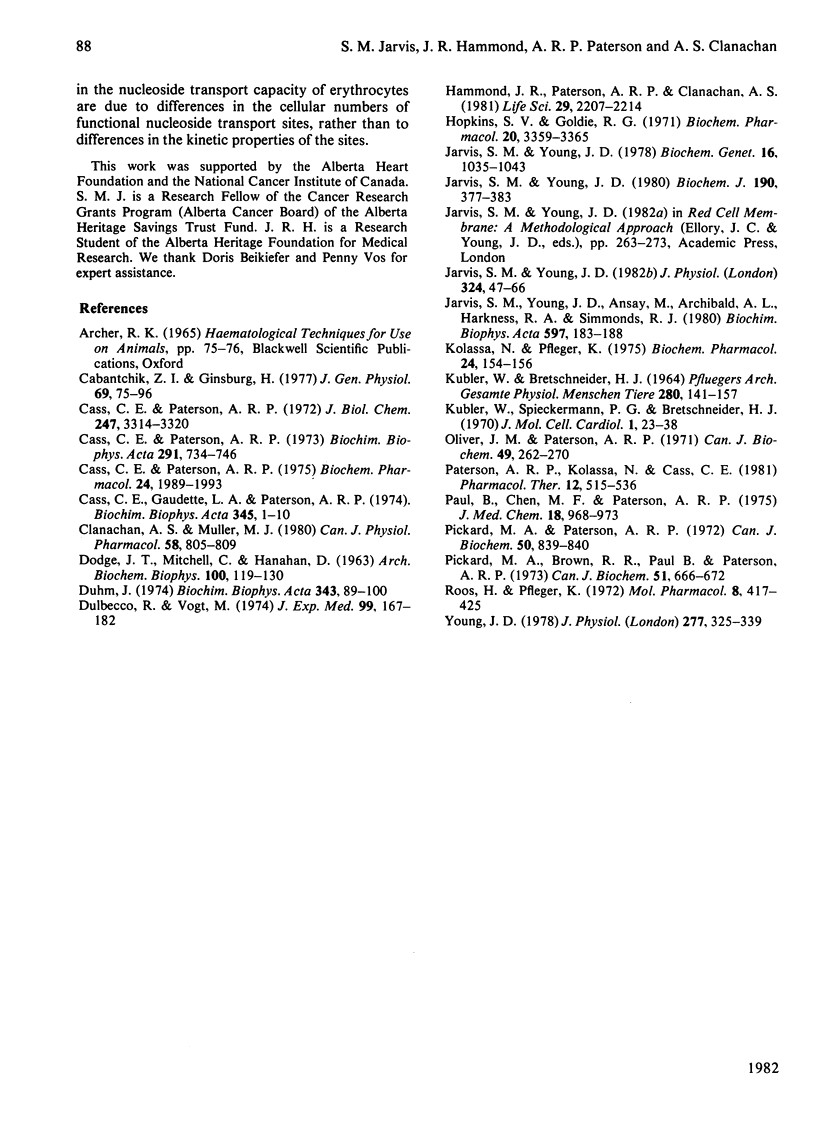
Selected References
These references are in PubMed. This may not be the complete list of references from this article.
- Cabantchik Z. I., Ginsburg H. Transport of uridine in human red blood cells. Demonstration of a simple carrier-mediated process. J Gen Physiol. 1977 Jan;69(1):75–96. doi: 10.1085/jgp.69.1.75. [DOI] [PMC free article] [PubMed] [Google Scholar]
- Cass C. E., Gaudette L. A., Paterson A. R. Mediated transport of nucleosides in human erythrocytes. Specific binding of the inhibitor nitrobenzylthioinosine to nucleoside transport sites in the erythrocyte membrane. Biochim Biophys Acta. 1974 Apr 12;345(1):1–10. doi: 10.1016/0005-2736(74)90239-9. [DOI] [PubMed] [Google Scholar]
- Cass C. E., Paterson A. R. Inhibition by nitrobenzylthioinosine of uptake of adenosine, 2'-deoxyadenosine and 9-beta-D-arabinofuranosyladenine by human and mouse erythrocytes. Biochem Pharmacol. 1975 Nov 1;24(21):1989–1993. doi: 10.1016/0006-2952(75)90387-1. [DOI] [PubMed] [Google Scholar]
- Cass C. E., Paterson A. R. Mediated transport of nucleosides by human erythrocytes. Specificity toward purine nucleosides as permeants. Biochim Biophys Acta. 1973 Feb 16;291(3):734–746. doi: 10.1016/0005-2736(73)90477-x. [DOI] [PubMed] [Google Scholar]
- Cass C. E., Paterson A. R. Mediated transport of nucleosides in human erythrocytes. Accelerative exchange diffusion of uridine and thymidine and specificity toward pyrimidine nucleosides as permeants. J Biol Chem. 1972 May 25;247(10):3314–3320. [PubMed] [Google Scholar]
- DODGE J. T., MITCHELL C., HANAHAN D. J. The preparation and chemical characteristics of hemoglobin-free ghosts of human erythrocytes. Arch Biochem Biophys. 1963 Jan;100:119–130. doi: 10.1016/0003-9861(63)90042-0. [DOI] [PubMed] [Google Scholar]
- DULBECCO R., VOGT M. Plaque formation and isolation of pure lines with poliomyelitis viruses. J Exp Med. 1954 Feb;99(2):167–182. doi: 10.1084/jem.99.2.167. [DOI] [PMC free article] [PubMed] [Google Scholar]
- Duhm J. Inosine permeability and purine nucleoside phosphorylase activity as limiting factors for the synthesis of 2,3-diphosphoglycerate from inosine, pyruvate, and inorganic phosphate in erythrocytes of various mammalian species. Biochim Biophys Acta. 1974 Mar 20;343(1):89–100. doi: 10.1016/0304-4165(74)90241-4. [DOI] [PubMed] [Google Scholar]
- Hammond J. R., Paterson A. R., Clanachan A. S. Benzodiazepine inhibition of site-specific binding of nitrobenzylthioinosine, an inhibitor of adenosine transport. Life Sci. 1981 Nov 23;29(21):2207–2214. doi: 10.1016/0024-3205(81)90492-6. [DOI] [PubMed] [Google Scholar]
- Hopkins S. V., Goldie R. G. A species difference in the uptake of adenosine by heart. Biochem Pharmacol. 1971 Dec;20(12):3359–3365. doi: 10.1016/0006-2952(71)90440-0. [DOI] [PubMed] [Google Scholar]
- Jarvis S. M., Young J. D., Ansay M., Archibald A. L., Harkness R. A., Simmonds R. J. Is inosine the physiological energy source of pig erythrocytes? Biochim Biophys Acta. 1980 Mar 27;597(1):183–188. doi: 10.1016/0005-2736(80)90162-5. [DOI] [PubMed] [Google Scholar]
- Jarvis S. M., Young J. D. Genetic control of nucleoside transport in sheep erythrocytes. Biochem Genet. 1978 Oct;16(9-10):1035–1043. doi: 10.1007/BF00483754. [DOI] [PubMed] [Google Scholar]
- Jarvis S. M., Young J. D. Nucleoside translocation in sheep reticulocytes and fetal erythrocytes: a proposed model for the nucleoside transporter. J Physiol. 1982 Mar;324:47–66. doi: 10.1113/jphysiol.1982.sp014100. [DOI] [PMC free article] [PubMed] [Google Scholar]
- Jarvis S. M., Young J. D. Nucleoside transport in human and sheep erythrocytes. Evidence that nitrobenzylthioinosine binds specifically to functional nucleoside-transport sites. Biochem J. 1980 Aug 15;190(2):377–383. doi: 10.1042/bj1900377. [DOI] [PMC free article] [PubMed] [Google Scholar]
- Kolassa N., Pfleger K. Adenosine uptake by erythrocytes of man, rat and guinea-pig and its inhibition by hexobendine and dipyridamole. Biochem Pharmacol. 1975 Jan 1;24(1):154–156. doi: 10.1016/0006-2952(75)90331-7. [DOI] [PubMed] [Google Scholar]
- Kübler W., Spieckermann P. G., Bretschneider H. J. Influence of dipyridamol (Persantin) on myocardial adenosine metabolism. J Mol Cell Cardiol. 1970 Mar;1(1):23–38. doi: 10.1016/0022-2828(70)90026-x. [DOI] [PubMed] [Google Scholar]
- Oliver J. M., Paterson A. R. Nucleoside transport. I. A mediated process in human erythrocytes. Can J Biochem. 1971 Feb;49(2):262–270. doi: 10.1139/o71-038. [DOI] [PubMed] [Google Scholar]
- Paterson A. R., Kolassa N., Cass C. E. Transport of nucleoside drugs in animal cells. Pharmacol Ther. 1981;12(3):515–536. doi: 10.1016/0163-7258(81)90096-6. [DOI] [PubMed] [Google Scholar]
- Paul B., Chen M. F., Paterson A. R. Inhibitors of nucleoside transport. A structure-activity study using human erythrocytes. J Med Chem. 1975 Oct;18(10):968–973. doi: 10.1021/jm00244a003. [DOI] [PubMed] [Google Scholar]
- Pickard M. A., Brown R. R., Paul B., Paterson A. R. Binding of the nucleoside transport inhibitor 4-nitrobenzylthioinosine to erythrocyte membranes. Can J Biochem. 1973 May;51(5):666–672. doi: 10.1139/o73-083. [DOI] [PubMed] [Google Scholar]
- Pickard M. A., Paterson A. R. Use of 4-nitrobenzylthioinosine in the measurement of rates of nucleoside transport in human erythrocytes. Can J Biochem. 1972 Jul;50(7):839–840. doi: 10.1139/o72-116. [DOI] [PubMed] [Google Scholar]
- Roos H., Pfleger K. Kinetics of adenosine uptake by erythrocytes, and the influence of dipyridamole. Mol Pharmacol. 1972 Jul;8(4):417–425. [PubMed] [Google Scholar]
- Young J. D. Nucleoside transport in sheep erythrocytes: genetically controlled transport variation and its influence on erythrocyte ATP concentrations. J Physiol. 1978 Apr;277:325–339. doi: 10.1113/jphysiol.1978.sp012274. [DOI] [PMC free article] [PubMed] [Google Scholar]


